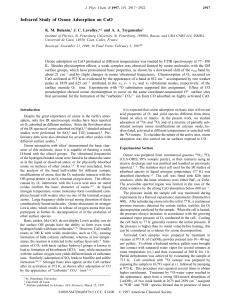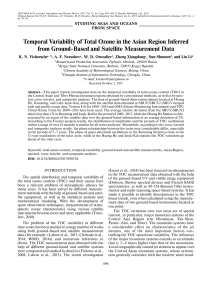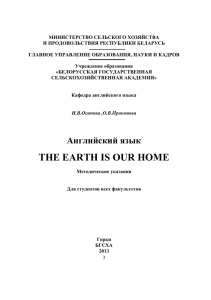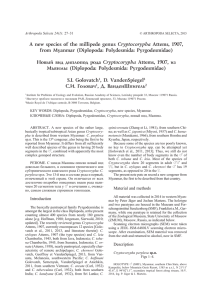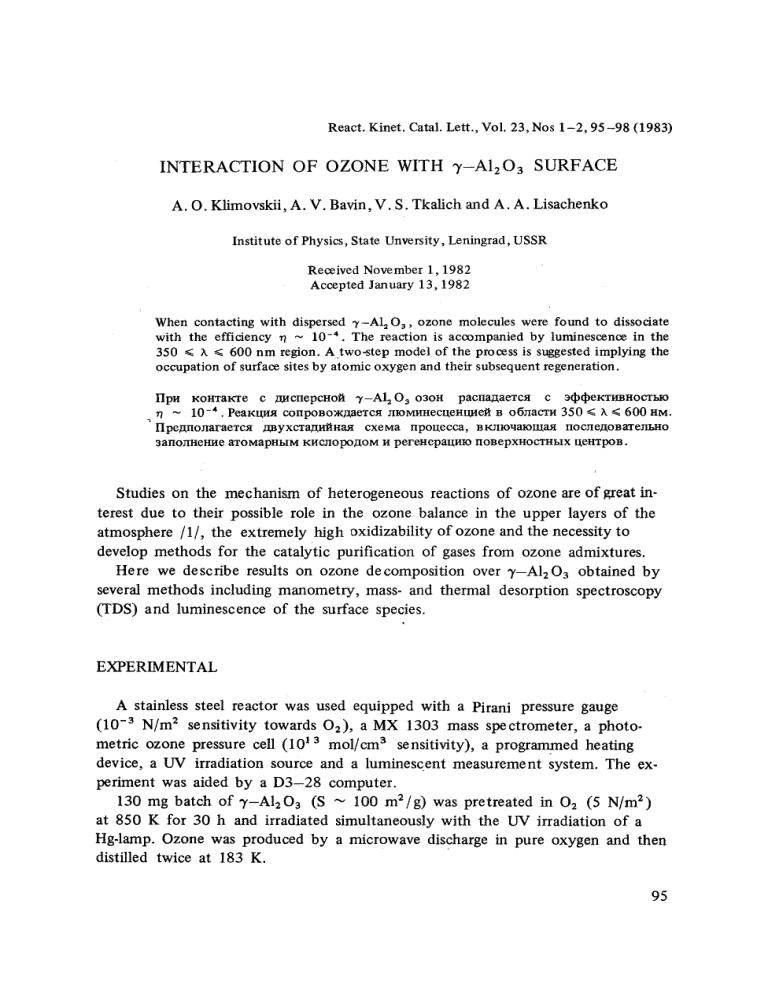
React. Kinet. Catal. Lett., Vol. 23, Nos 1-2, 95-98 (1983) INTERACTION OF OZONE WITH 7-A1203 SURFACE A. O. Klimovskii, A. V. Bavin, V. S. Tkalich and A. A. Lisachenko Institute of Physics, State Unversity, Leningrad, USSR Received November 1, 1982 Accepted January 13, 1982 When contacting with dispersed ,y-A12 O~, ozone molecules were found to dissociate with the efficiency r/ ~ 10 -4 . The reaction is accompanied by luminescence in the 350 ~ h ~< 600 nm region. Atwo-step model of the process is suggested implying the occupation of surface sites by atomic oxygen and their subsequent regeneration. HpH KOHTaKTe C g2elcIlepcHoi~l 3,-A120 a O3OH pacna~aeTca c aqbqbeKTl, IBItocrhlO n ~ 10 -4 9Peaxuna conpoBo~/~aeTc~I3nOMHHeCReHILqe!~IB o6JIac'rn350 ~<X~<600 HM. Ilpe~nonaraeTcz nayxcra~m~Ha~ cxeMa npot~ecca, Bxmona~omaa nocne~oBaTen~qo zanonnenne aTOMapHbIMKrIcnopo~oMH pereHepatteao noBepxHocTm,IXttenTpOB. Studies on the mechanism of heterogeneous reactions of ozone are of great interest due to their possible role in the ozone balance in the upper layers of the atmosphere /1/, the extremely high oxidizability of ozone and the necessity to develop methods for the catalytic purification of gases from ozone admixtures. Here we describe results on ozone decomposition over 3,-A1203 obtained by several methods including manometry, mass- and thermal desorption spectroscopy (TDS) and luminescence of the surface species. EXPERIMENTAL A stainless steel reactor was used equipped with a Pirani pressure gauge (10 -3 N/m s sensitivity towards O2), a MX 1303 mass spectrometer, a photometric ozone pressure cell (1013 mol/cm 3 sensitivity), a programmed heating device, a UV irradiation source and a luminescent measurement system. The experiment was aided by a D 3 - 2 8 computer. 130 mg batch of ~'-A1203 (S ~" 100 mS/g) was pretreated in 02 (5 N/m s) at 850 K for 30 h and irradiated simultaneously with the UV irradiation of a Hg-lamp. Ozone was produced by a microwave discharge in pure oxygen and then distilled twice at 183 K. 95 KLIMOVSKII et al.: INTERACTION OF OZONE RESULTS Changes in the ozone concentration when contacting with the 7-A12Oa sample are illustrated in Fig. 1 (curve 1). Taking the surface area of the sample to be equal to the geometrical one, the portion of the active (i.e. resulting in ozone decomposition) collisions with the surface at 293 K is 10 -4. In the 1013 ~< [03] <~ ~< 3 • 10 is molec 9 cm -3 region the ozone concentration decreases exponentially with a simultaneous increase in the pressure of molecular oxygen (Fig. 1, curve 2). Part of the oxygen molecules remains in the adsorbed state. The analysis of the adsorbed phase indicates that the thermal desorption spectra of O2 after ozone decomposition (Fig. 2, curve 3) differs from those of chemisorption (curve 1) or photoadsorption (curve 2) of molecular oxygen in the total coverage and the much P tP greater relative population of the phases at Tmax ~ 550 and Tmax ~ 715 K. The high-temperature phases are generally ascribed to the dissociated species of o x y g e n / 2 / It has been established that the admission of ozone to the sample leads to a flash emission in the 350 ~< X ~< 600 nm region. This effect is partly reproduced if a new doze of ozone is admitted, but for its complete restoration, heating at T/> 750 K under high vacuum is necessary. The estimated quantum yield was found to be not less than 10 -6 per one ozone molecule dissociated. Besides the short-time flash of luminescence (several seconds), a slowly decreasing (10 3 S) light emission was detected whose intensity sharply increases after the evacuation of oxygen (Fig. 1, curve 3). This emission is accompained by Oxygen (O2) desorption. Pumping-out ~ r-= 8 *03 ~ //2 " " " & E U m To 2 O I /~0 80 &O0 t (s) 800 1200 Fig. 1. Kinetics of the interaction of ozone with 7-AI~ O~: ozone concentration (1), oxygen concentration (2), luminescence intensity (3) 96 KLIMOVSKII et al.: INTERACTION OF OZONE r 2] > ~5 3 7~ \ Z "U I 300 ~.00 500 600 700 800 T I~() Fig. 2. Thermal desorption of molecular oxygen: after chemisorption of molecular oxygen: after ehemisorption of 02 (1), photoadsorption of 02 (2) and adsorption of 03 (3) DISCUSSION A two-step scheme of heterogeneous decomposition of ozone /3/ is: o~ + ( ) ~ ( o ) + o~ (1) O3 +(o) K~ 202 + ( ) (2) where ( ) are the active surface centers. Reaction (2) is supposed to be the ratedetermining step. On oxide surfaces, active sites can be the anion vacancies. The analysis indicates that this scheme accounts for the kinetic peculiarities of the ozone decomposition and the formation of high-temperature maxima in the thermal desorption spectra after contact with Oa. It can also account for the observed flash luminescence. Actually, protons can be emitted after the insertion of atomic oxygen into the surface either directly by the transition complex or due to the surface defect, which consumed the released energy. In order to explain the slowly decreasing light emission one must suppose that the (O) centers are mobile enough to recombine via the scheme: (0) + (0) K~ 2( ) + 0= + hz, 7 (3) 97 KLIMOVSKIIet al.: INTERACTIONOF OZONE This reaction can also account for the desorption of 02. The quenching effect of oxygen might be attributed to the blocking of emitting centers with the formation of three-atomic surface complexes, whose existence was reported in several works/2/. REFERENCES 1. R. D. Cadle, P. Crutzen, D. Enhalt: J. Geophys. Res., 80, 3381 (1975). 2. K. N. Spixidonov,O. V. Krylov: in Probl. Kinet. Katal., 16, 21 (1975). 3. G. I. Golodets: HeterogeneousCatalytic Reactions InvolvingMolecular Oxygen, Kiev 1977. 0 98


